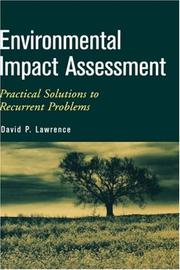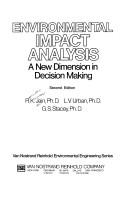| Listing 1 - 10 of 2889 | << page >> |
Sort by
|

ISBN: 0471457221 9780471457220 Year: 2003 Publisher: New York (N.Y.) : Wiley-Interscience,
Abstract | Keywords | Export | Availability | Bookmark
 Loading...
Loading...Choose an application
- Reference Manager
- EndNote
- RefWorks (Direct export to RefWorks)
Book
ISBN: 0948277009 9780948277009 Year: 1985 Publisher: Cambridge Scientific Committee on Antarctic Research
Abstract | Keywords | Export | Availability | Bookmark
 Loading...
Loading...Choose an application
- Reference Manager
- EndNote
- RefWorks (Direct export to RefWorks)
Outlines environmental impact assessment procedures and likely impacts from continued research activities in Antarctica.
Environmental impact analysis --- Environmental impact analysis. --- Antarctica.
Book
Year: 1983 Publisher: Louvain-la-Neuve: UCL. Groupe de sociologie wallonne,
Abstract | Keywords | Export | Availability | Bookmark
 Loading...
Loading...Choose an application
- Reference Manager
- EndNote
- RefWorks (Direct export to RefWorks)
Book
ISBN: 9012017505 Year: 1977 Publisher: 's-Gravenhage : Staatsuitgeverij,
Abstract | Keywords | Export | Availability | Bookmark
 Loading...
Loading...Choose an application
- Reference Manager
- EndNote
- RefWorks (Direct export to RefWorks)
Book
ISBN: 1857281179 1857281187 Year: 1995 Publisher: London UCL press
Abstract | Keywords | Export | Availability | Bookmark
 Loading...
Loading...Choose an application
- Reference Manager
- EndNote
- RefWorks (Direct export to RefWorks)
Book
ISBN: 0415441749 0415441757 9780415441742 9780415441759 Year: 2009 Publisher: London Routledge
Abstract | Keywords | Export | Availability | Bookmark
 Loading...
Loading...Choose an application
- Reference Manager
- EndNote
- RefWorks (Direct export to RefWorks)
Book
ISBN: 9780429875441 0429464371 0429875436 0429875444 Year: 2020 Publisher: Boca Raton : CRC Press,
Abstract | Keywords | Export | Availability | Bookmark
 Loading...
Loading...Choose an application
- Reference Manager
- EndNote
- RefWorks (Direct export to RefWorks)
This bookis a primer for those interested in a career in this dynamic, multidisciplinary field as well as a handy reference for practicing consultants. Combining theory and practice advice into a concise, readable format, the book is an accessible introduction to the types of projects you will encounter as an environmental consultant and lays the groundwork for what you'll need to know in this challenging and rewarding profession. Also available with this book, under the Additional Resourcs tab, are PowerPoint lectures that correspond with each chapter. New in the Second Edition Covers the latest environmental issues, including emerging contaminants, and the latest technological advances in environmental investigation and remediation New chapters dedicated to vapor intrusion investigation and mitigation and to Brownfields redevelopment and project financing. An expanded chapter describing the staffing, budgeting, and execution of environmental projects. Descriptions of the remediation processes under RCRA and Superfund Descriptions on how each chapter's subject matter applies to the job of the environmental consultant. Dozens of new figures, photographs, and tables designed to enhance the reader's understanding of the subject matter. Problems and questions to be used for homework assignments or classroom discussions.
Book
ISBN: 9781138647640 1138647640 9781138647671 1138647675 Year: 2018 Publisher: New York, NY Routledge, an imprint of the Taylor & Francis Group
Abstract | Keywords | Export | Availability | Bookmark
 Loading...
Loading...Choose an application
- Reference Manager
- EndNote
- RefWorks (Direct export to RefWorks)
Environmental and social impact assessment (ESIA) is an important and often obligatory part of proposing or launching any development project. Delivering a successful ESIA needs not only an understanding of the theory but also a detailed knowledge of the methods for carrying out the processes required. Riki Therivel and Graham Wood bring together the latest advice on best practice from experienced practitioners to ensure an ESIA is carried out effectively and efficiently.
Book
Year: 1999 Publisher: Cambridge, Mass. National Bureau of Economic Research
Abstract | Keywords | Export | Availability | Bookmark
 Loading...
Loading...Choose an application
- Reference Manager
- EndNote
- RefWorks (Direct export to RefWorks)
This paper explores the trade-off between incentive effects and administrative costs associated with the implementation of various environmental tax instruments, with special reference to carbon taxes. In a simple model, we show under what conditions it is optimal to use input rather than emission taxes to internalize environmental externalities. Mixed tax regimes are also studied. If linkage of emissions to inputs is close, if abatement possibilities are costly, and if administrative costs of emission taxes are high, emission taxes should not be introduced. It is shown that these conditions directly apply to current tax policies toward CO2 emissions in several European countries that harness pre-existing energy taxes. First, there is a one-to-one correspondence between carbon content of energy and CO2 emissions. Second, only few possibilities exist to abate CO2 emissions separately. Third, energy excises allow to save on administrative costs. Broadening the carbon tax base by removing certain widely-used exemptions for energy production (and possibly adding emission taxes or abatement subsidies for selected industries) is likely to increase incentives for carbon reduction without significant additional administrative costs.

Abstract | Keywords | Export | Availability | Bookmark
 Loading...
Loading...Choose an application
- Reference Manager
- EndNote
- RefWorks (Direct export to RefWorks)
| Listing 1 - 10 of 2889 | << page >> |
Sort by
|

 Search
Search Feedback
Feedback About UniCat
About UniCat  Help
Help News
News